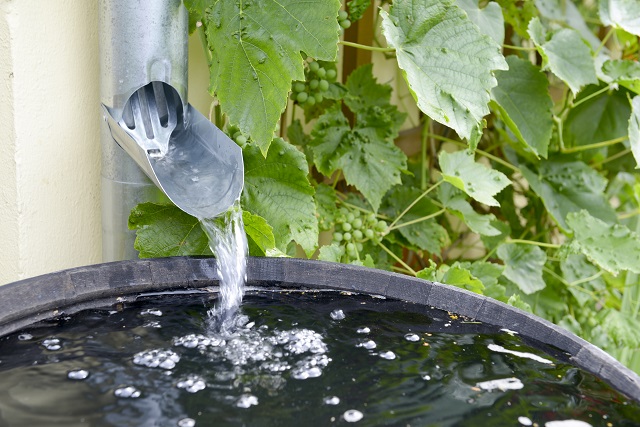
A rain barrel is a small, above-ground tank that collects and stores rainwater for later use. There are a few types, but the most common ones collect rainwater from your roof. Adding one or two rain barrels to your home can be good for your plants, the planet, and your wallet. It’s an inexpensive, practical habit, especially in in dry, western states where droughts are more common.
Here are 8 reasons to put a rain barrel in your yard.
1. Benefits of Rainwater over Tap
Natural rainwater is loaded with oxygen and nutrients. Rainwater collected from roofs – except for copper roofs and those treated to prevent moss and algae growth – is free from chlorine, ammonia, and other chemicals contained in tap water that can accumulate in the soil over time. Rainwater dilutes the impact of these chemicals, making plants healthier and more drought-tolerant. Rainwater also contains good bacteria and microorganisms that the soil needs to keep plants healthy.
2. Save Water and Money
Water-intensive landscapes and green lawns cost a lot of money. In dry climates and during the summer, homeowners can use 2 to 4 times more water, according to the EPA. A rain barrel’s “water catch” can collect 1,300 gallons of water during the growing season. Irrigating with rainwater could reduce your water bill by 30% or more.
One inch of rainfall on a 1,000 square foot roof yields over 600 gallons of water. Even in dry areas, less than an inch of rain can fill a rain barrel. Cutting back on water use for your lawn and garden not only reduces your water footprint, but it can also cut down your water bill.
3. More than Lawn and Garden
Rainwater has many uses aside from watering plants. It doesn’t have the salt and chemicals found in tap water, making it perfect for washing your car or filling a bird bath (birds love fresh rainwater). The rain barrel itself can double as a trellis, block an unsightly view, or even provide passive solar heat if you install a system and find the right size, color, and location on your lawn.
4. No Drought Restrictions
If you collect rainwater, you’ll be able to keep watering and nourishing your garden all summer long. This includes when water advisories are put in place to limit residential water usage from the tap or sprinklers.
5. Protect Your Basement and Foundation
Rainwater from a big storm can flood your basement or create a build-up of moisture next to your foundation, leading to damp patches and mold. Rain barrels help prevent these potentially dangerous problems by protecting the already-saturated ground from excess water.
6. Prevent Sewage Overflow
Runoff from rainy and snowy weather can cause flooding downstream and overflow at sewage treatment plants. Collecting the rain water that lands on your roof might seem like a small effort, but it helps minimize flooding and leaks further downstream. If you don’t need a full rain barrel to care for your lawn and garden or other activities, you can slowly release excess in between storms. This allows the water to soak into the ground instead of running into storm sewers.
7. Reduce Urban Water Pollution
Urban areas covered with concrete, tarmac, and buildings create runoff during heavy storms which can carry pollutants into waterways. Collecting rainwater can reduce the amount of runoff and prevent some of that pollution from reaching waterways near you.
8. Help Your Local Water Treatment Facility
Capturing rainwater and putting it straight to use in your garden eliminates the need for energy-intensive and expensive water treatment in the community
By investing a small amount of time and money in a rain barrel, you can save on your water bill and create a healthy, natural garden.
 Organic Home Gardening Tips to Feed Your Whole Family
Organic Home Gardening Tips to Feed Your Whole Family  Composting and Landscaping at Home
Composting and Landscaping at Home  Xeriscaping: The Low-Water (Low-Effort) Landscaping Solution
Xeriscaping: The Low-Water (Low-Effort) Landscaping Solution  Xeriscaping: Environmentally Wise Landscaping
Xeriscaping: Environmentally Wise Landscaping  Stunning Roof Gardens Also Have Beautiful Advantages
Stunning Roof Gardens Also Have Beautiful Advantages 

How do you avoid algea growing in it?
I question your statement: “A rain barrel’s ‘water catch’ can collect 1,300 gallons of water during the growing season.” I’ve heard this figure attributed to the EPA in other articles, but never says how this figure was obtained. It would have to rain a sufficient amount of rain to fill a 65 gallon rain barrel 20 times in the 3-month summer season to attain this 1300 gallons. Where? Certainly not in California!
Could you please provide a reference to the research that backs up this 1300 gallon estimate?